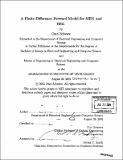A finite difference forward model for MEG and EEG
Author(s)
Schwarz, Omri
DownloadFull printable version (3.764Mb)
Other Contributors
Massachusetts Institute of Technology. Dept. of Electrical Engineering and Computer Science.
Advisor
Eric Grimson.
Terms of use
Metadata
Show full item recordAbstract
In this thesis, I designed and implemented a model of the electromagnetic signals generated by the human brain as seen on magnetoencephalography and electroencephalography machines. The model makes a novel use of the principle of reciprocity combined with Ohm's Law and the Biot Savart Law to build a model of the human magnetoencephalogram that is much faster to compute than the current state of the art. The model uses an existing finite difference model for electroencephalography and modifies it to incorporate the Bi6t Savart Law into its geometry. I tested the model against a spherical model to show that it is highly sensitive to approximations made of the Bi6t Savart Law for finite plane-bounded elements, but that further refinements of the model could make it as accurate as regular finite element models for magnetoencephalography.
Description
Thesis (M. Eng. and S.B.)--Massachusetts Institute of Technology, Dept. of Electrical Engineering and Computer Science, September 2006. Includes bibliographical references (p. 45-50).
Date issued
2006Department
Massachusetts Institute of Technology. Department of Electrical Engineering and Computer SciencePublisher
Massachusetts Institute of Technology
Keywords
Electrical Engineering and Computer Science.